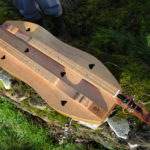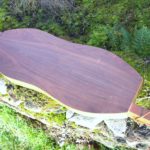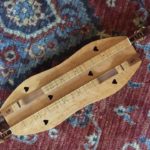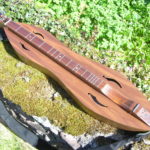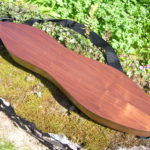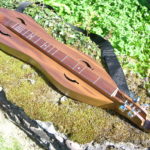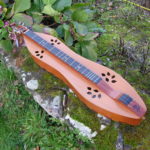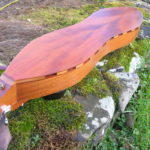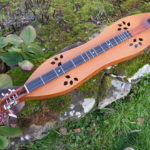Black Rose Hourglass Dulcimers
These dulcimers were built in the Appalachian foothills of Southern Ohio by Bill Todd, now in his 60s. On his former website, Todd quotes from an unemployed miner who described coal as a rose when discovered, providing jobs and hope, but which left poverty and dereliction after it ran out. “The rose that once seemed so beautiful was as black as the coal we had mined from the ground.” Todd made dulcimers in a variety of woods, some with galax (double) backs. He also made banjimers – a hybrid dulcimer/banjo.
2.186 1999 Black Rose Courting Dulcimer #218.
Oblong white printed label with black rose illustration and “BRD” in RH bottom corner: “Appalachian Built By/ Bill Todd/ Bill [signature]/ Date: Oct. 99 [h/w] Number: 218 [h/w].” Black Rose design branded on top end of fingerboard/tailpiece, behind string anchors.
Classic Black Rose design, with equal-sized bouts, the body made of walnut, bookmatched on sides and back, and the top made of spectacular birdseye maple, with heart soundholes facing inwards (four outside the paired fingerboards and two inside. Fingerboard is walnut with a thick maple overlay, walnut (?) markers at frets 3, 7 and 10, 6+ but not 13+ frets, bone (?) nut (slotted for 3 or 4 courses) and a floating (rosewood?) wood bridge with a triangular profile. String anchors are simple copper pins, positioned at end of fingerboard. Typical walnut BR hooked scroll, positioned low down, and high-sided pegbox with gold, enclosed tuners. Seems to have thick sides and limited internal strutting, except for substantial walnut strut down centre of back. Hollow underneath each fingerboard. With a courting dulcimer, the heads are always difficult to integrate structurally with the broad body and a protruding head each end makes them vulnerable to knocks. True to form, one of the heads was moving ever so slightly and needed re-bedding and gluing/clamping. Now secure and cosmetically impossible to distinguish from the other.
Overall length 45” [38” each head to tail], upper bout 11¾ [equivalent to 8” single bout], lower bout ditto, depth 2⅜”, FBW 1½”, VSL 25½” (medium scale), weight 6lb 01oz (2750g), strings now 11, 14, 24w and 12, 15, 25w. Each fingerboard has a 6+ but not 13+fret.
Very clear sound, emphasizing the treble but without too much stridency. Pretty good intonation with floating bridge. Unlike some big-bodied courting dulcimers, has power without boominess. Impressive.
Click on images below to enlarge.
2.157 2004 Hourglass #507 £Sold
Oblong white printed label: “Black Rose Dulcimers/ Appalachian Built By/ Bill Todd/ [signature]/ Date Apr. 1 04 [h/w] Number 507 [h/w].” Black Rose design branded on top end of fingerboard/tailpiece, behind string anchors. Full address is: 39980 White Road, Nelsonville, Ohio 45764 Tel. 740-753-2381 Email Bill_Todd@Yahoo.com . Old website: http://www.oocities.org/heartland/hills/8841/ .
All walnut hourglass, bookmatched top and back. Long, deepish body with scimitar-like soundholes. Walnut fingerboard (hollowed by a ¾” x ⅜” channel) with markers at frets 3,7, and 10; 6+ and 13+ frets. Floating ebony bridge and bone nut. Copper pin string anchors (for ball or loop end strings) mounted on far end of fingerboard, but within length of body (a la Folkcraft or FolkRoots). Odd shaped, deep pegbox with good quality enclosed tuners (Ping?) and small hook scroll. Black strap buttons each end and two brass pins at each end of fingerboard to drop the nearest melody string if you want to play 3 string set-up.
Overall length 37”, upper bout 6½”, lower bout 7½”, depth 2¼”, FBW 1½”, VSL 26″ (medium scale), weight 2lb 9oz (1184g), strings (?original) 13/13, 14, 24w, now 12/12, 14, 24w. Has a 6+ and 13+fret.
Nicely constructed from good materials. Intonation and action are good. Has great softish (walnut?) tone and surprising volume, considering the weight of the body and thickness of top/bottom. Errs perhaps towards the bassier end of the spectrum, unusually for a dulcimer. Needs as incisive a melody string as action will take.
Click on images below to enlarge.
2.173 2004 Black Rose Hourglass with galax back #548 £Sold
Oblong white printed label: “Black Rose Dulcimers/ Appalachian Built By/ Bill Todd/ [signature]/ Date Nov 04 [h/w] Number 548 [h/w].”
The body is made from curly (rippled) mahogany and is fully bookmatched. This example has a resonator back, sometimes called a Galax back, after the Virginian town where big, resonator back dulcimers were created to compete with other instruments in string bands. This has a mahogany outer back and a white-wood inner back, the former mounted on softwood spacers about 1” to 1.5” apart. The top is spruce with small, leaf-shaped soundholes. The fingerboard is also mahogany and arched to allow maximum flexibility for the top. It has a ebony overlay, a floating (i.e. not fixed) pyramid-section ebony bridge, a composite nut and copper pin string anchors. There is a Black Rose logo on the tail, as usual. The head has a low-slung hooked scroll and a high-sided pegbox with decent quality enclosed, geared tuners. It has pins on the nearside of the fingerboard to allow one of the doubled melody strings to be dropped when required, so that it can play as a 3 string. It has both 6+ and 13+ frets.
Overall length 37¼”, upper bout 6¼”, lower bout 7¼”, depth 2¼ (2⅝” with resonator), FBW 1⅝”, VSL 26″ (medium scale), weight 2lb 14oz (1310g), strings now 11/11, 14, 24w. Has 6+ and 13+fret.
Generally in good condition with only a few scuffs on top and edges, but seems to have suffered some impact damage to the top. This has been solidly, but clumsily, repaired by a previous owner. Far side top also had a hairline, almost invisible crack from a soundhole which I have stabilised and which is no longer moving. This is a bold dulcimer with a forceful sound, when required, but not lacking in charm. Intonation is good. A strong-voiced resonator dulcimer is a rare find and this example is well-built and works extremely effectively, unhindered by a few cosmetic imperfections.
Click on images below to enlarge.

